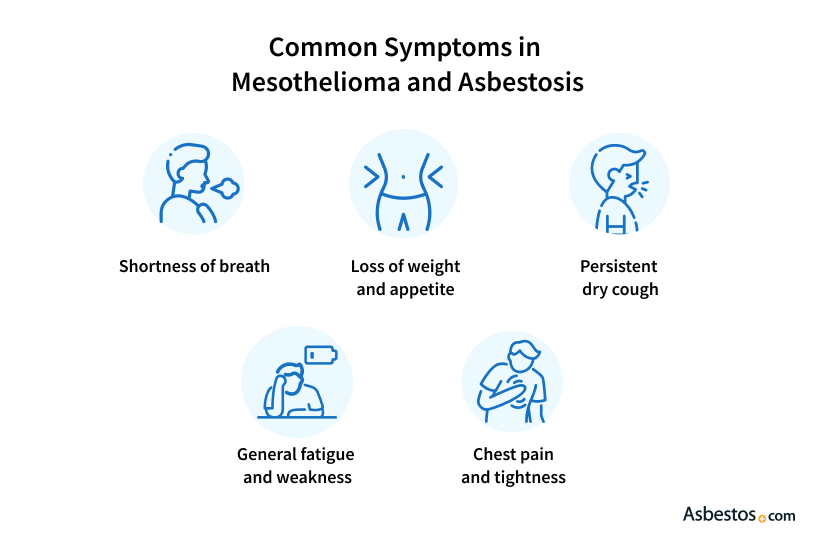Get Your Free Mesothelioma Guide

Find a Top Mesothelioma Doctor

Access Help Paying for Treatment

Asbestosis and mesothelioma are caused by asbestos exposure, but they are different diseases. Asbestosis is a lung disease that causes inflammation and scarring in the lungs. Mesothelioma is a cancer that develops in the lining of the lungs, abdomen, heart and testes.

Mesothelioma and asbestosis are two lung diseases caused by asbestos exposure. Mesothelioma is a rare but aggressive cancer. Asbestosis causes inflammation and scarring in the lungs but is not cancer. Mesothelioma can take decades to develop, while asbestosis can develop in a matter of years. If you have been exposed to asbestos, it is important to see a doctor for regular checkups.
Malignant mesothelioma is a type of cancer, and asbestosis is a form of pulmonary fibrosis. DNA damage from asbestos causes unrestricted cell growth that leads to tumors.
Pulmonary fibrosis, such as asbestosis, is not cancer. It is scar tissue in the lungs that restricts breathing by thickening and stiffening the tissue.
| Facts About Asbestosis | Facts About Mesothelioma |
|---|---|
| Asbestosis is not cancer. It only affects the lungs and the respiratory tract. | Mesothelioma is a cancer. It develops in mesothelial tissue lining certain organs. |
| Asbestosis is incurable. With treatment, patients can survive at least a decade. | Mesothelioma has no cure. The average life expectancy is 12 to 21 months. |
| Scar tissue can cause respiratory distress. | Tumors cause difficulty breathing, chest pain and fatigue. |
Asbestosis creates irreversible scar tissue that gradually worsens breathing. It doesn’t cause tumors and is limited to the lungs and respiratory tract. In contrast, mesothelioma is a type of cancer. It can develop in the linings of the lungs, abdomen, heart or testes.
Prognosis and life expectancy also differ between asbestosis and mesothelioma. Mesothelioma treatment is challenging. Only 23% of patients survive for three or more years. Asbestosis is a chronic, incurable lung disease. Treatment can extend survival for about a decade.
Get Your Free Mesothelioma Guide

Find a Top Mesothelioma Doctor

Access Help Paying for Treatment

Asbestosis isn’t cancer, but it has similar symptoms to mesothelioma, such as shortness of breath. Inflammation from asbestos exposure contributes to both diseases.

Mesothelioma patients experience shared symptoms more severely earlier in their disease than asbestosis patients. Asbestosis patients may not have severe symptoms until many years after diagnosis.
Both diseases can also cause a condition called pleural effusion. As swelling and inflammation increase over time, cell waste and fluid build up in the lung lining. The increased pressure on the lungs worsens symptoms and can lead to respiratory distress.
Navy veteran Jerry Cochran was told 50 years ago that he had only five years to live. But he said his faith in God and his work advocating for others has kept him going for the past half a century.
Asbestos-related diseases develop from long or repeated exposure to asbestos fibers. These tiny, needle-like fibers release into the air when asbestos materials are damaged.
The body struggles to get rid of inhaled asbestos fibers. Some fibers stay in the lungs, pleura and other tissues. The immune system tries to remove them with inflammation. Prolonged inflammation leads to damage and scarring, resulting in asbestos-related diseases.
Mesothelioma and asbestos-related lung cancer stem from DNA damage. Asbestos fibers trigger ongoing inflammation that damages DNA. Bad DNA causes uncontrolled cell growth, which forms tumors. These tumors can then spread throughout the body.
Ongoing lung inflammation causes scar tissue that leads to asbestosis. Scar tissue is tougher than healthy tissue. This makes the lungs stiff, restricting their ability to expand for a full breath. Scar tissue in the alveoli blocks oxygen from entering the bloodstream. Patients cope with chronic deficiencies in oxygen and respiratory complications that progress with age.

Asbestos exposure can cause a wide range of diseases, not always just mesothelioma or malignant diseases such as lung cancer. Asbestosis is the term for the disease process that affects the lungs when asbestos fibers are trapped within the lungs for a long period of time and cause scar tissue after long periods of inflammation and irritation.
Diagnosing any asbestos-related disease requires medical and occupational screening. Symptoms and imaging scans won’t help unless there’s a known asbestos exposure history. Biopsies are the best tests to diagnoses these conditions.
The first step in diagnosing both diseases is talking with a primary care physician about respiratory changes or other health issues. A doctor will order a chest X-ray or CT scan to determine if there are visual abnormalities in the lungs. This is according to a 2021 review by the U.S. National Library of Medicine.
The first signs of these conditions might show up on scans as denser spots. These spots could be scar tissue or tumors. A biopsy can tell asbestosis apart from mesothelioma.
Biopsies That Identify Asbestosis and Mesothelioma
These procedures may also help physicians identify signs of pleural thickening or pleural effusion. In most cases, doctors do not rule out cancer until a biopsy is returned negative.

Gain access to top mesothelioma doctors and get help scheduling appointments.
Connect NowTreatment for mesothelioma includes surgery, immunotherapy, chemotherapy and radiation. Asbestosis treatment involves surgery, medications and pulmonary therapy. Both asbestosis and mesothelioma patients may use pain medication to reduce breathing discomfort. Asbestosis patients are also likely to receive breathing treatments with bronchodilators.
1 year vs. 10 years
Average survival time of people with mesothelioma vs. asbestosis.
Source: Cleveland Clinic
Most asbestosis treatments involve surgery to drain fluid from the chest and lungs. In severe cases, a lung transplant might be an option. However, this is not available for asbestos cancer.
Asbestosis worsens with age. Patients will need more treatments, such as oxygen and antibiotics. Ongoing treatment manages symptoms and prevents infections.
Recommended ReadingYour web browser is no longer supported by Microsoft. Update your browser for more security, speed and compatibility.
If you are looking for mesothelioma support, please contact our Patient Advocates at (855) 404-4592
The Mesothelioma Center at Asbestos.com has provided patients and their loved ones the most updated and reliable information on mesothelioma and asbestos exposure since 2006.
Our team of Patient Advocates includes a medical doctor, a registered nurse, health services administrators, veterans, VA-accredited Claims Agents, an oncology patient navigator and hospice care expert. Their combined expertise means we help any mesothelioma patient or loved one through every step of their cancer journey.
More than 30 contributors, including mesothelioma doctors, survivors, health care professionals and other experts, have peer-reviewed our website and written unique research-driven articles to ensure you get the highest-quality medical and health information.
My family has only the highest compliment for the assistance and support that we received from The Mesothelioma Center. This is a staff of compassionate and knowledgeable individuals who respect what your family is experiencing and who go the extra mile to make an unfortunate diagnosis less stressful. Information and assistance were provided by The Mesothelioma Center at no cost to our family.LashawnMesothelioma patient’s daughter


Marchese, S. (2025, May 16). Mesothelioma vs. Asbestosis. Asbestos.com. Retrieved June 30, 2025, from https://www.asbestos.com/asbestosis/mesothelioma/
Marchese, Sean. "Mesothelioma vs. Asbestosis." Asbestos.com, 16 May 2025, https://www.asbestos.com/asbestosis/mesothelioma/.
Marchese, Sean. "Mesothelioma vs. Asbestosis." Asbestos.com. Last modified May 16, 2025. https://www.asbestos.com/asbestosis/mesothelioma/.
An occupational scientist or another expert who specializes in occupational hazards reviewed the content on this page to ensure it meets current scientific standards and accuracy.
Arti Shukla, Ph.D., is an internationally renowned asbestos researcher known for her achievements in identifying biomarkers that cause mesothelioma. She is the director of the Shukla Research Lab, as well as a professor of pathology at The University of Vermont Larner College of Medicine.
Our fact-checking process begins with a thorough review of all sources to ensure they are high quality. Then we cross-check the facts with original medical or scientific reports published by those sources, or we validate the facts with reputable news organizations, medical and scientific experts and other health experts. Each page includes all sources for full transparency.
Please read our editorial guidelines to learn more about our content creation and review process.
